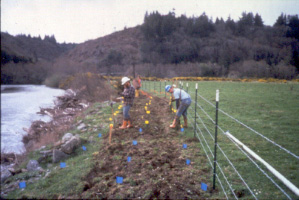Local officials in Washington County, Oregon are hoping than two new incentive programs that encourage farmers to voluntarily plant riparian buffers will help them achieve water quality goals over the Tualatin River watershed at lower cost than an engineered solution. These two programs, which complement, existing USDA cost-share programs, offer growers the option of either receiving higher subsidy payments under long-term contracts, or earning income from crops grown inside the buffers without contract enrollments.
Washington County, west of Portland, is the first Oregon county to offer Enhanced Conservation Reserve Enhancement Program (Enhanced CREP) and Vegetated Buffer Areas for Conservation and Commerce (VEGBACC). According to Amber Reese, program manager with the Tualatin Soil & Water Conservation District (TSWCD), "the development of these two new programs, have been in response to low agricultural producer participation in the CRP/CREP program in the Tualatin River Basin." Because of high land values and the potential of higher profits from high value crops, agricultural producers in the Tualatin Basin have been reluctant to enroll. Development of CREP and VEGBACC programs, have been the result of action by local conservation agencies over the past two years.
 |
Local government encourages landowners in Washington County, Oregon to plant new riparian buffers that will create shade and lower stream temperatures (Photo by D. Godwin) |
Reese stated "these programs have been designed to encourage voluntary participation of rural landowners to meet the water quality goals to reduce stream water temperature in the Tualatin Basin." The initial goal is to enroll and plant native trees and shrubs along 35 miles of stream in the next five years. After careful study, the County determined that mitigation of excess heat loads from its wastewater treatment facilities, required by state water quality rules, could be achieved at lower cost by subsidizing an increase in natural tree shade along streams in the Tualatin River watershed than by installing refrigeration equipment at its two treatment plants.
Enhanced CREP
Enhanced CREP provides annual payments to landowners with payment rates much higher than the current CREP program offered by USDA. Contracts are up to 15 years in length with annual rental payments. In addition there are incentive payments for the lease/purchase of older water rights, sign-up bonuses and practice incentive payments. Qualification for the cumulative impact incentive payment has been made easier. Landowners now only need to get to together to plant 50% of a two mile stream reach to receive a one time cumulative impact bonus payment. Areas which initially don't make the 50% level are paid this one time payment when other neighbors sign contracts and the fifty percent stream reach goal is met.
An added bonus for landowners is that the Tualatin Soil and Water Conservation District (SWCD) if requested by the program participant will assume responsibility for buffer conversion. This includes site preparation, tree planting and maintenance.
According to Amber Reese, Landowner Incentive Program Coordinator, "the new buffer programs will reduce the time and financial commitment from the agricultural producer and that's time and money they can use for of their farming operation." Other options available include semi/permanent conservation easements with the Tualatin Soil and Water Conservation District as the holder of the easement.
VEGBACC
The VEGBACC program is designed for landowners who only want to plant trees and not enroll their land in the Enhanced CREP program. VEGBACC provides free planting materials, cost-sharing for maintenance, and free technical assistance. This program is open to landowners that have at least 300 linear feet of perennial stream on their property. In addition, property enrolled in VEGBACC must not be subject to the Oregon Forest Practices Act. Limited continued commercial use of the property is allowed outside of the minimum buffer width.
Unique to the VEGBACC program, landowners may continue to produce crops in the portion of the buffer that is more than 20 feet from the streambank (Zone 2). Production and harvest operations will be designed to minimize disruption of the ecological functions of the buffer. Timber can be selectively harvested, pastures cut for hay, and nontimber products such as boughs can be collected for making holiday wreaths. As part of the required Conservation Plan, participating landowners will work with TSWCD staff to determine suitable commercial uses of the buffer.
One commercial enterprise that landowners participating in VEGBACC may pursue is the propagation and sale of cuttings of native plants to the District. As an inducement for landowners to sell long-term conservation easements over the portion of their land in buffers, they become eligible to supply the TSWCD pole cuttings on a multi-year contract at prevailing wholesale rates. The District will use these cuttings to provide free plant material for other growers participating in buffer restoration programs.
For more information, visit the Tualatin SWCD at www.swcd.net , or contact Amber Reese, (503) 648-3174 orThis email address is being protected from spambots. You need JavaScript enabled to view it.. More background on the development of these cost-share programs can be viewed atwww.oracwa.org/Pages/B.CordonCREP.pdf .
By Miles Merwin, Editor



